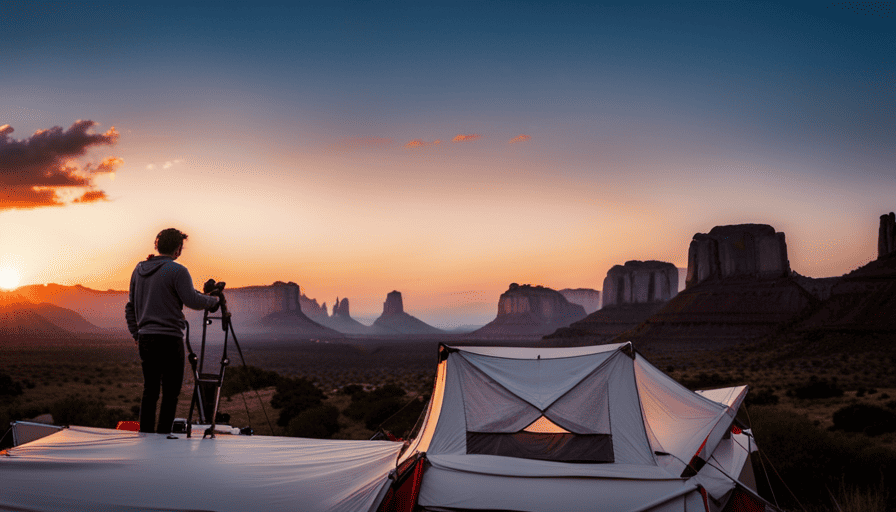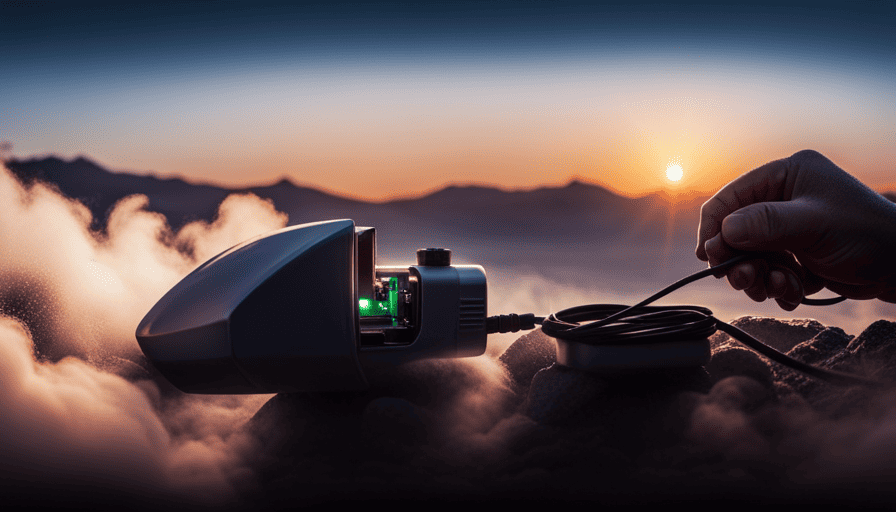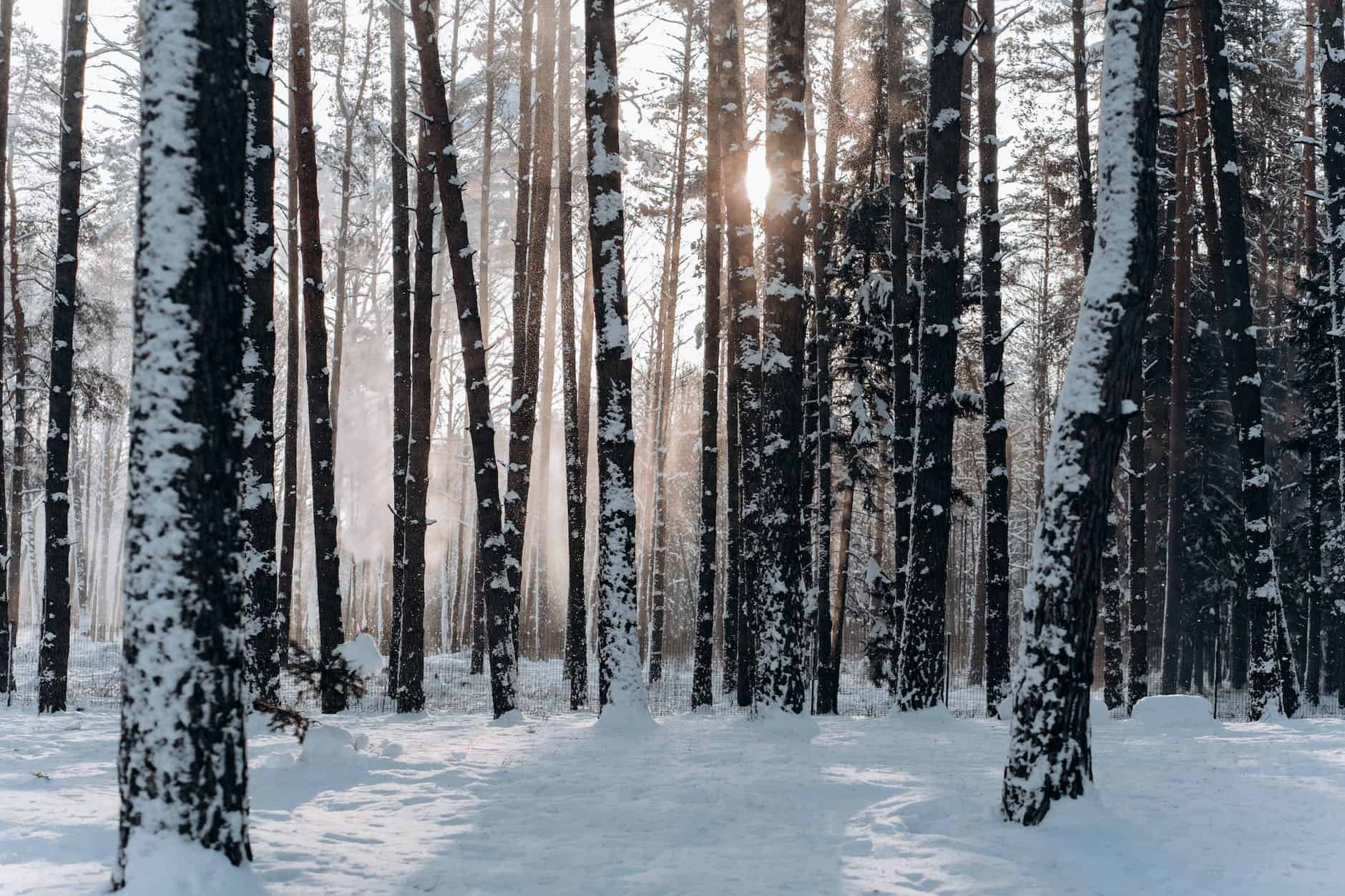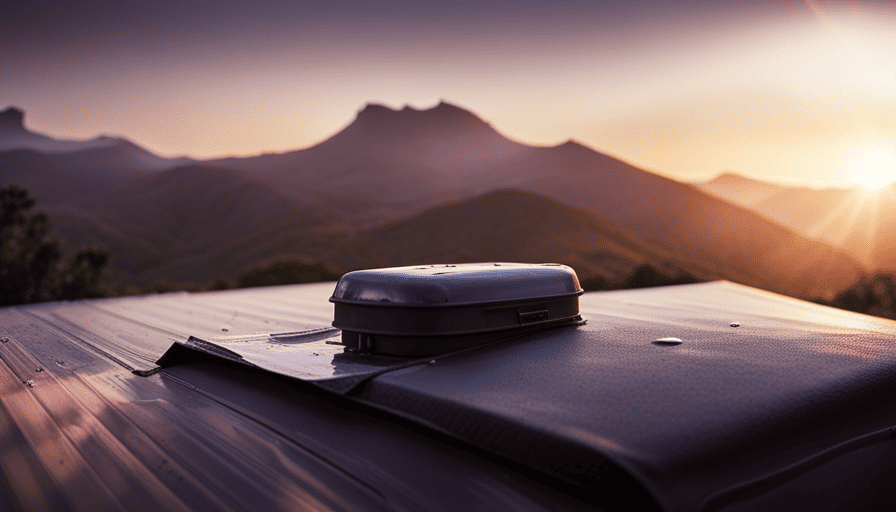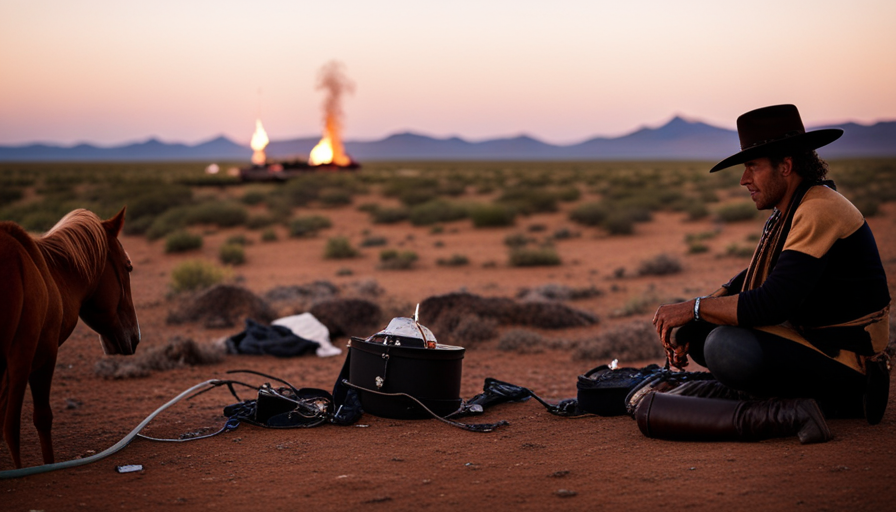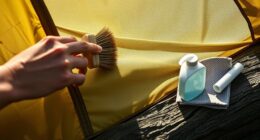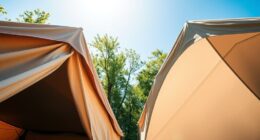Have you ever found yourself in a tricky situation trying to back up a pop-up camper? Trust me, I can relate to that frustrating feeling. The combination of anxiety and frustration can be overwhelming, especially when there are people watching and waiting for you to make a mistake. But fear not, as I am here to share my tips and tricks for mastering the art of reversing a pop-up camper.
In this article, I will guide you through the basics of towing a pop-up camper and walk you through the essential steps to prepare your vehicle for towing. We’ll discuss the importance of practicing in an open space and using your mirrors and rearview camera effectively. I’ll even teach you how to communicate with a spotter and use hand signals and verbal cues to ensure a seamless backing-up process.
But that’s not all. We’ll also delve into the intricacies of maneuvering in tight spaces and paying attention to the terrain. I’ve learned the hard way that practice makes perfect, so get ready to gain the confidence and skills needed to back up your pop-up camper like a pro.
Get ready to conquer those tight spots with ease!
Key Takeaways
- Understanding the basics of towing a pop-up camper is essential for safe and successful backing up.
- Clear communication with a spotter is crucial during the backing up process to prevent accidents and build trust.
- Practicing maneuvering skills in an open space and gradually challenging oneself with tighter spaces improves towing skills and builds confidence.
- Properly preparing the vehicle for towing, including checking towing equipment, adjusting tire pressure, and installing a compatible trailer hitch, ensures a safe journey.
Understand the Basics of Towing a Pop-Up Camper
Before you can hit the road with your pop-up camper, it’s important to understand the basics of towing it. Towing a pop-up camper requires some knowledge and experience to ensure towing safety and proper weight distribution.
First and foremost, it’s crucial to understand the weight of your pop-up camper and how it affects your towing capacity. The weight of the camper, along with any additional cargo, shouldn’t exceed the maximum towing capacity of your vehicle. Exceeding this limit can lead to poor handling, decreased braking performance, and potential damage to your vehicle.
Additionally, it’s essential to distribute the weight properly within the camper. This means placing heavier items towards the front and lower areas of the camper to maintain stability and prevent swaying while on the road. Proper weight distribution can greatly improve the towing experience and reduce the risk of accidents.
Now that you understand the basics of towing a pop-up camper, it’s time to prepare your vehicle for towing. This involves inspecting your vehicle’s towing equipment, such as the hitch and wiring connections, ensuring they’re in good working condition. It’s also important to check the tire pressure and adjust it according to the manufacturer’s recommendations for towing. By properly preparing your vehicle, you’ll be ready to hit the road with confidence and enjoy your pop-up camper adventure.
Prepare Your Vehicle for Towing
To ensure a safe journey, it’s important to properly equip your vehicle for towing a popup trailer. Before hitting the road, there are a few key steps to take in order to prepare your vehicle for towing.
First, make sure your vehicle is capable of towing the weight of the pop-up camper by checking the towing capacity in your vehicle’s manual.
Next, install a trailer hitch that’s compatible with your vehicle and can handle the weight of the camper. This will provide a secure connection between your vehicle and the trailer.
Additionally, consider installing trailer brakes if your pop-up camper exceeds a certain weight threshold, as this’ll help with braking control.
Lastly, don’t forget to check your vehicle’s tire pressure and ensure they’re properly inflated for towing.
By properly equipping your vehicle for towing, you can have peace of mind knowing that you’re prepared for the journey ahead.
Once your vehicle’s ready, the next step is to practice towing in an open space to get comfortable with the handling and maneuverability of your setup.
Practice in an Open Space
Get ready to hit the open road and gain confidence in your towing skills by practicing in a spacious area where you can freely maneuver your vehicle and trailer. Practicing in an open space offers numerous benefits that can greatly enhance your towing experience.
Here are three reasons why practicing in an open space is advantageous:
-
Freedom of Movement: In an open space, you have the freedom to make wide turns, change lanes, and practice backing up without the fear of hitting any obstacles. This allows you to get a feel for how your vehicle and trailer respond, improving your overall control and confidence.
-
Visibility: Open spaces provide better visibility, allowing you to see any potential hazards or obstacles from a distance. This gives you more time to react and make necessary adjustments while towing.
-
Reduced Stress: Practicing in a spacious area reduces the stress and pressure of towing in congested or tight spaces. It gives you the opportunity to focus solely on mastering your towing skills without worrying about damaging your vehicle or trailer.
While practicing in an open space has its benefits, it also comes with its own set of challenges. The lack of defined boundaries and obstacles can make it difficult to judge distances accurately. It’s essential to be aware of these challenges and practice caution when maneuvering your vehicle and trailer.
Transitioning into the next section about using your mirrors and rearview camera, it’s crucial to utilize these tools effectively to overcome the challenges of practicing in an open space.
Use Your Mirrors and Rearview Camera
Navigating through an open space with confidence, your mirrors and rearview camera act as your guiding eyes, allowing you to effortlessly anticipate any potential obstacles or hazards. These essential tools provide a comprehensive view of your surroundings, giving you the assurance you need when backing up your pop-up camper.
To fully utilize your mirrors and rearview camera, it’s important to understand their capabilities and how to interpret the information they provide. Let’s take a closer look:
| Mirror and Rearview Camera Tips | Benefits |
|---|---|
| Adjust your mirrors properly | Optimal visibility |
| Use wide-angle mirrors | Expanded field of view |
| Regularly check your rearview camera | Enhanced depth perception |
| Utilize blind spot mirrors | Minimized blind spots |
| Be mindful of mirror positioning | Reduced blind spots |
By effectively utilizing these tools, you can confidently navigate through tight spaces, maneuver around obstacles, and ensure the safety of your pop-up camper. However, relying solely on mirrors and a rearview camera is not always sufficient. In the next section, we will discuss how to further enhance your backing up skills by effectively communicating with a spotter.
Transitioning seamlessly into the subsequent section, communicating with a spotter is another invaluable technique to assist you during the backing up process.
Communicate with a Spotter
Transitioning smoothly into the next step, effectively communicating with a spotter can greatly enhance your ability to safely maneuver your pop-up camper in reverse. When it comes to backing up a pop-up camper, clear communication is key.
While some may prefer hand signals, others find verbal communication more effective. Personally, I’ve found that a combination of both works best. Hand signals can be easily understood and provide clear instructions to the driver. However, verbal communication allows for immediate feedback and adjustments, ensuring a smooth and controlled movement.
When communicating with a spotter, it’s crucial to establish a set of clear signals or phrases beforehand. This ensures that both the spotter and the driver are on the same page and understand each other’s intentions. For example, a raised hand could mean ‘stop,’ while a sweeping motion could indicate which direction to turn the wheel.
The importance of clear communication can’t be overstated. It not only prevents accidents but also helps build trust and confidence between the driver and the spotter. By effectively conveying your intentions and receiving accurate feedback, you can navigate tight spaces, avoid obstacles, and park your pop-up camper with ease.
With communication covered, the next step is to take it slow and steady, ensuring a safe and controlled movement.
Take It Slow and Steady
As you ease your way in reverse, like a graceful turtle through a field of flowers, maintaining a slow and steady pace will ensure a safe and controlled movement of your pop-up camper. When it comes to backing techniques for a pop-up camper, taking it slow and steady is key.
Here are four important tips to consider:
-
Use your mirrors: Adjust your side mirrors so you have a clear view of both sides of the camper. This will help you gauge the distance between your vehicle and any obstacles.
-
Practice in an empty space: Before attempting to back up your pop-up camper in a crowded campground, find an open area where you can practice your maneuvering skills. This will help build your confidence and improve your spatial awareness.
-
Use a spotter: Having someone outside the vehicle to guide you can greatly enhance your visibility. Establish clear hand signals or verbal communication with your spotter before you begin.
-
Take safety precautions: Always check for any obstacles or hazards behind you before you start backing up. Be aware of the height and width of your camper to avoid collisions or damage.
As you master the art of backing up your pop-up camper, the next step is to learn how to use hand signals and verbal communication effectively.
Use Hand Signals and Verbal Communication
As mentioned in the previous section, it is crucial to take it slow and steady when backing up a pop-up camper. However, another essential aspect of successful backing up is effective communication between the driver and the spotter. This is where hand signals and verbal communication come into play.
Hand signals are a universal language that allows the spotter to guide the driver with ease. By using predetermined signals, such as raising one hand to indicate "stop" or pointing in a specific direction to indicate which way to turn the wheel, the spotter can effectively convey instructions to the driver. Verbal communication is also vital, as it provides an additional layer of clarity and ensures that both parties are on the same page.
To help further understand the importance of spotter communication and safety precautions, I have created a table that outlines some common hand signals and their meanings:
| Hand Signal | Meaning |
|---|---|
| Raised hand | Stop |
| Pointing | Turn left/right |
| Circular motion with hand | Back up |
By utilizing these hand signals and maintaining clear verbal communication, the backing up process becomes smoother and safer. Now that we have covered the importance of spotter communication, let’s move on to the next section and discuss how to pay attention to the terrain while backing up a pop-up camper.
Pay Attention to the Terrain
Paying close attention to the terrain while maneuvering can greatly enhance the safety and ease of backing a pop-up camper. Terrain challenges can arise in various forms, such as uneven ground, steep slopes, or loose gravel. These factors can affect the stability and control of the camper, making it crucial to navigate carefully.
To overcome terrain challenges, it’s important to take safety precautions. Before backing up, I always survey the area for any potential hazards or obstacles. This can include rocks, tree stumps, or low-hanging branches that could damage the camper. Additionally, I ensure that the tires have proper traction by choosing the right tire type and adjusting the tire pressure accordingly.
When encountering uneven or sloping terrain, I take extra care to maintain control of the camper. I approach at a slow and steady pace, keeping a firm grip on the steering wheel. By doing so, I can anticipate any shifts in weight and make gradual adjustments to maintain stability. If the terrain is particularly challenging, I might enlist the help of a spotter to guide me through the obstacles.
Paying attention to the terrain and taking safety precautions are essential for a successful backing maneuver. It not only protects the camper from potential damage but also ensures the safety of everyone involved. By being aware of the terrain challenges and following these guidelines, I can confidently navigate through different types of terrain.
Transitioning into the subsequent section about learning to maneuver in tight spaces, understanding the terrain provides a solid foundation for mastering the art of navigating confined areas.
Learn to Maneuver in Tight Spaces
After carefully navigating through different types of terrain, it’s crucial to master the art of maneuvering in tight spaces when it comes to backing up a pop-up camper. This skill becomes particularly important when trying to park the camper in crowded campgrounds or campsite areas with limited space.
To successfully maneuver in tight spaces, there are several techniques and strategies that can be employed:
-
Utilize your mirrors: Adjust your side mirrors to provide the best possible view of the camper and the surrounding area. Constantly check the mirrors to ensure you’re aware of your surroundings while maneuvering.
-
Use a spotter: If possible, have someone outside the vehicle assisting you by providing guidance and directions. Their vantage point can help you navigate through narrow paths and avoid obstacles.
-
Take it slow and steady: When maneuvering in tight spaces, it’s crucial to proceed slowly and with caution. Abrupt movements can lead to accidents or damage to the camper.
By employing these maneuvering techniques and parking strategies, you can confidently navigate your pop-up camper through tight spaces and park it with precision. Remember, practice, practice, practice is the key to mastering these skills and becoming a proficient pop-up camper driver.
Practice, Practice, Practice
Mastering the art of maneuvering in tight spaces with a pop-up camper requires consistent practice to become a pro. It’s not something that can be perfected overnight, but with dedication and patience, anyone can improve their skills and build confidence. The key is to practice, practice, practice.
One of the best ways to improve your skills is to find a safe and open space to practice maneuvering your pop-up camper. This could be an empty parking lot or a spacious field where you have plenty of room to make turns and navigate obstacles. Start by practicing basic maneuvers such as reversing, turning, and parking. As you become more comfortable, challenge yourself with tighter spaces and more complex situations.
Another helpful tip is to set up a course with cones or markers to simulate real-life scenarios. This will allow you to practice navigating around objects and develop your spatial awareness. By repeatedly going through these exercises, you’ll start to develop muscle memory and gain a better understanding of how your pop-up camper responds to different movements.
As you continue to practice, you’ll notice your skills improving and your confidence growing. Maneuvering in tight spaces will become second nature, and you’ll be able to handle any challenge that comes your way. Remember, practice is the key to mastering this skill, so don’t be afraid to get out there and put in the time and effort.
Frequently Asked Questions
What are the legal requirements for towing a pop-up camper?
When it comes to towing a pop-up camper, it’s important to be aware of the legal requirements.
Before hitting the road, ensure that your vehicle is capable of towing the weight of the camper and that you have the proper towing equipment, such as a hitch and safety chains.
Additionally, make sure you are familiar with the towing laws and regulations in your area, including speed limits and any necessary permits.
Following these tips for safe towing will help ensure a smooth and legal journey.
How do I properly distribute the weight in my pop-up camper for safe towing?
Proper weight distribution in your pop-up camper is crucial for safe towing. By evenly distributing the weight, you can prevent swaying and maintain control on the road.
One interesting statistic to note is that nearly 30% of accidents involving trailers are caused by improper weight distribution. To ensure towing safety, place heavier items in the center of the camper and distribute weight evenly side to side. This will help you maintain stability and enjoy a smooth journey.
What should I do if my pop-up camper starts to sway while I’m towing it?
If my pop-up camper starts to sway while I’m towing it, there are a few steps I can take to prevent further swaying.
First, I need to make sure that the weight distribution in my camper is correct. Properly distributing the weight will help keep the camper stable on the road.
Additionally, I should check the tire pressure and make sure it’s at the recommended levels.
Finally, I can consider using a weight distribution hitch, which can help minimize swaying. Understanding the common causes of pop-up camper swaying is essential for safe towing.
How often should I check the tire pressure on my pop-up camper?
Checking the tire pressure on my pop-up camper is an essential part of regular maintenance. It ensures optimal performance and safety on the road. I personally make it a habit to check the tire pressure before every trip.
Did you know that, according to a recent study, maintaining proper tire pressure can improve fuel efficiency by up to 3%? It’s a small step that can have a big impact on both your wallet and the environment.
Are there any specific maintenance tasks I should perform on my pop-up camper before and after each trip?
Before and after each trip with my pop-up camper, I make sure to perform specific maintenance tasks to ensure a smooth and safe journey.
I always go through a pre-trip checklist to make sure everything is in order. This includes checking the tire pressure, inspecting the exterior and interior for any damages or leaks, testing the lights and brakes, and ensuring all the necessary supplies and equipment are packed.
Taking these precautions helps me avoid any unexpected issues and enjoy my trips worry-free.
Are the Steps to Back Up a Pop Up Camper the Same as a Camper Trailer?
Are the steps to back up a pop up camper the same as a camper trailer? While both involve navigating in reverse, there are some differences. Pop up campers are generally lighter and have a narrower profile, making them easier to maneuver. However, the basic principles of backing up a camper trailer, such as checking mirrors, using a spotter, and making small adjustments, still apply.
Conclusion
In conclusion, mastering the art of backing up a pop-up camper is no small feat. It requires patience, skill, and a willingness to learn from your mistakes. But fear not, with practice and determination, you can become a pro at maneuvering in tight spaces and navigating tricky terrains.
So, don’t be discouraged if it takes a few tries to get it right. Embrace the challenge and soon you’ll be handling your pop-up camper with finesse and ease. Happy camping!

